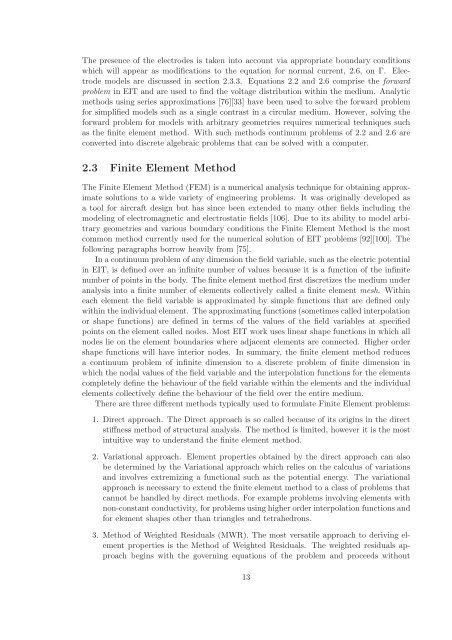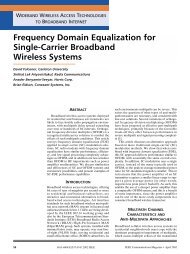Image Reconstruction for 3D Lung Imaging - Department of Systems ...
Image Reconstruction for 3D Lung Imaging - Department of Systems ...
Image Reconstruction for 3D Lung Imaging - Department of Systems ...
You also want an ePaper? Increase the reach of your titles
YUMPU automatically turns print PDFs into web optimized ePapers that Google loves.
The presence <strong>of</strong> the electrodes is taken into account via appropriate boundary conditions<br />
which will appear as modifications to the equation <strong>for</strong> normal current, 2.6, on Γ. Electrode<br />
models are discussed in section 2.3.3. Equations 2.2 and 2.6 comprise the <strong>for</strong>ward<br />
problem in EIT and are used to find the voltage distribution within the medium. Analytic<br />
methods using series approximations [76][33] have been used to solve the <strong>for</strong>ward problem<br />
<strong>for</strong> simplified models such as a single contrast in a circular medium. However, solving the<br />
<strong>for</strong>ward problem <strong>for</strong> models with arbitrary geometries requires numerical techniques such<br />
as the finite element method. With such methods continuum problems <strong>of</strong> 2.2 and 2.6 are<br />
converted into discrete algebraic problems that can be solved with a computer.<br />
2.3 Finite Element Method<br />
The Finite Element Method (FEM) is a numerical analysis technique <strong>for</strong> obtaining approximate<br />
solutions to a wide variety <strong>of</strong> engineering problems. It was originally developed as<br />
a tool <strong>for</strong> aircraft design but has since been extended to many other fields including the<br />
modeling <strong>of</strong> electromagnetic and electrostatic fields [106]. Due to its ability to model arbitrary<br />
geometries and various boundary conditions the Finite Element Method is the most<br />
common method currently used <strong>for</strong> the numerical solution <strong>of</strong> EIT problems [92][100]. The<br />
following paragraphs borrow heavily from [75].<br />
In a continuum problem <strong>of</strong> any dimension the field variable, such as the electric potential<br />
in EIT, is defined over an infinite number <strong>of</strong> values because it is a function <strong>of</strong> the infinite<br />
number <strong>of</strong> points in the body. The finite element method first discretizes the medium under<br />
analysis into a finite number <strong>of</strong> elements collectively called a finite element mesh. Within<br />
each element the field variable is approximated by simple functions that are defined only<br />
within the individual element. The approximating functions (sometimes called interpolation<br />
or shape functions) are defined in terms <strong>of</strong> the values <strong>of</strong> the field variables at specified<br />
points on the element called nodes. Most EIT work uses linear shape functions in which all<br />
nodes lie on the element boundaries where adjacent elements are connected. Higher order<br />
shape functions will have interior nodes. In summary, the finite element method reduces<br />
a continuum problem <strong>of</strong> infinite dimension to a discrete problem <strong>of</strong> finite dimension in<br />
which the nodal values <strong>of</strong> the field variable and the interpolation functions <strong>for</strong> the elements<br />
completely define the behaviour <strong>of</strong> the field variable within the elements and the individual<br />
elements collectively define the behaviour <strong>of</strong> the field over the entire medium.<br />
There are three different methods typically used to <strong>for</strong>mulate Finite Element problems:<br />
1. Direct approach. The Direct approach is so called because <strong>of</strong> its origins in the direct<br />
stiffness method <strong>of</strong> structural analysis. The method is limited, however it is the most<br />
intuitive way to understand the finite element method.<br />
2. Variational approach. Element properties obtained by the direct approach can also<br />
be determined by the Variational approach which relies on the calculus <strong>of</strong> variations<br />
and involves extremizing a functional such as the potential energy. The variational<br />
approach is necessary to extend the finite element method to a class <strong>of</strong> problems that<br />
cannot be handled by direct methods. For example problems involving elements with<br />
non-constant conductivity, <strong>for</strong> problems using higher order interpolation functions and<br />
<strong>for</strong> element shapes other than triangles and tetrahedrons.<br />
3. Method <strong>of</strong> Weighted Residuals (MWR). The most versatile approach to deriving element<br />
properties is the Method <strong>of</strong> Weighted Residuals. The weighted residuals approach<br />
begins with the governing equations <strong>of</strong> the problem and proceeds without<br />
13





